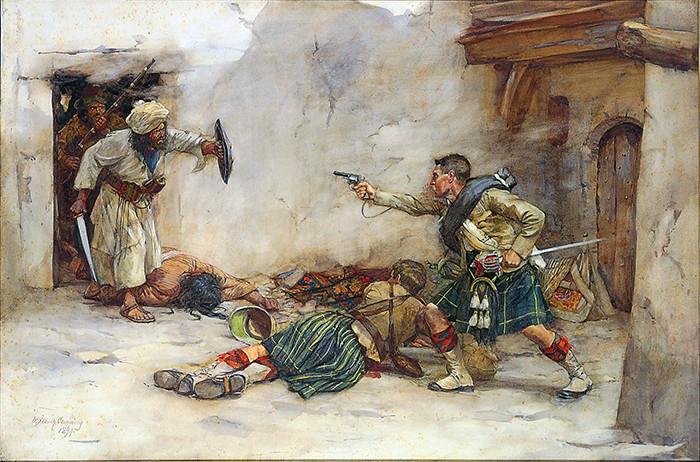
“It instantly struck a nerve in the United States. Until that moment, few Americans had paid much attention to the atrocities being committing by the Japanese army in its murderous march across China.”
ON OCT. 4, 1937, tens of millions of Americans opened their new issue of Life magazine and came face-to-face with a startling photograph.
Embedded within an article covering the latest news from Japan’s ongoing war in China, the image showed an infant sitting upright in the smoking ruins of a bombed out Shanghai railway station. The child, whose clothes appear to have been burned off, is alone and wailing in agony.
The shot was snapped just moments after Japanese warplanes struck the city, which at the time was the sixth largest metropolis on earth. Hundreds died in the attack; thousands more were wounded. The photo powerfully conveyed the human side of the tragedy in a way that words or civilian casualty statistics could not.
It instantly struck a nerve in the United States. Until that moment, few Americans had paid much attention to the atrocities being committing by the Japanese army in its murderous march across China. As far as most westerners were concerned, the war in Asia was somebody else’s problem — certainly none of Washington’s business. Life’s photo spread helped shift those opinions.

Entitled “Bloody Saturday” or just “Shanghai Baby,” the photo instantly became a lighting rod for anti-Japanese sentiment in the U.S. Its publication would later stand out as one many waypoints on the road to war between Japan and the United States.
A 37-year-old Hearst Newspaper chain photojournalist by the name of H.S. Wong captured the now famous image shortly after 4 p.m. on Aug. 28, 1937 when Japanese bombers levelled a crowded Shanghai railway station. The terminal was packed with thousands of refugees, all of whom were hoping to flee the burning city by train. After being tipped off that warplanes were about to strike, several reporters, including Wong, gathered on a nearby rooftop to take in the grim spectacle. Immediately following the attack, the newsmen rushed to the station to document the carnage.

“It was a horrible sight,” Wong later recalled. “Dead and injured lay strewn across the tracks and platform. Limbs lay all over the place. I stopped to reload my camera. I noticed that my shoes were soaked with blood.” [1]
Wong spied a helpless infant sitting beside some of the smouldering wreckage. A few feet away lay the lifeless body of the child’s mother. The photographer stole a few frames and then took some footage of the heart-wrenching scene with a 35 mm movie camera he was carrying.
Moments later, an adult male, presumably the child’s father, arrived on scene. Emergency responders tended to the youngster as best they could before the man and child disappeared into the crowd. Wong never learned the infant’s name or fate.

Wong developed his film the following day and showed what he’d captured to the editors of the China Press newspaper. They were blown away by the explosive visuals. He delivered his negatives to a U.S warship departing Shanghai for the Philippines. From there, the package was put aboard a flight heading stateside.
Footage of the helpless infant appeared in newsreels as early as mid-September. By the end of the month, it was being seen in movie houses all over the United States. As many as 25 million Americans witnessed the brief sequence. [2] The stills were picked up by Hearst newspapers and ran coast to coast and internationally. By October, it’s estimated that 136 million people had seen Wong’s now iconic image.
The photograph became an instant sensation. It aroused indignation in coffee shops, saloons and living rooms across the United States, not to mention the corridors of power.
Once isolationist legislators changed course and went on record with hawkish tirades against Japan. Nebraska senator and noted foreign policy dove George Norris described Tokyo’s militarist regime as “disgraceful,” “barbarous” and “cruel.”
Relations between Tokyo and Washington became further strained in the wake of the photo’s publication as the U.S. retaliated against Japan through diplomatic pressure and economic sanctions. Within four years, the two countries would be at war.

While many pointed to the image as evidence of the threat Japan posed to world peace, Tokyo declared the picture a hoax and placed a $50,000 price on Wong’s head.
Despite the risks, Wong continued to cover the war in China, often putting himself in the way of the bullets to get his shots. After a number of close calls, he eventually fled to Hong Kong. He continued to work as a photojournalist until 1970. Wong died in Taipei in 1981. He was 81 years old.
His famous image would go on to become one of the most influential photographs of all time. Not only did it serve as a grim foreshadow of the horrors that lay ahead in World War Two, Wong’s motherless war child personified all civilian victims of conflict in general. The photo has since appeared in numerous retrospectives of the 20th Century.
Some have attempted to make the case that Wong manipulated the scene, reportedly going so far as to physically place the infant in the frame. Others have claimed that the photographer touched up the image in the darkroom afterwards, adding smoke for dramatic effect. However eyewitnesses have defended the shots as authentic.
(Originally published in MilitaryHistoryNow.com on May 27, 2015)
SOURCES
http://www.famouspictures.org/bloody-saturday/
http://www.lomography.com/magazine/259072-influential-photographs-bloody-saturday-1937-by-h-s-wong
https://iconicphotos.wordpress.com/tag/h-s-wong/
http://en.wikipedia.org/wiki/Bloody_Saturday_(photograph)












I remember sitting in local movie thereatre during thewar asalittle girl and newsreels showed Japanes soldiers throwing babies into the air and bayonetting them to death,
Many dont remember or think I am crazy but I know I saw it.